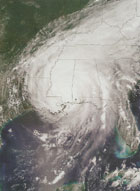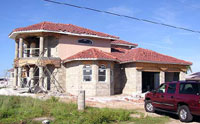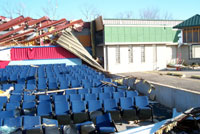Windy Conditions No Cause for Worry with Reinforced Masonry
Walls constructed using masonry units, steel reinforcement, and grout are strong. When high winds occur, reinforced masonry buildings resist the pressures and flying debris that can knock down or damage less robust construction.
CSU’s Hurricane Season 2007
 Faculty from Colorado State University predicted the 2007 hurricane season would be busier than an average season based on the period from 1950 to 2000. Both the total number (9 instead of the average 5.9) and increased intensity (Category 3 or above for five hurricanes instead of the average 2.3) were above average.
Faculty from Colorado State University predicted the 2007 hurricane season would be busier than an average season based on the period from 1950 to 2000. Both the total number (9 instead of the average 5.9) and increased intensity (Category 3 or above for five hurricanes instead of the average 2.3) were above average.
Their hurricane forecast was upwardly revised from the prior forecast in early December, they said, due to weather conditions they reviewed. They pointed out two eye-opening facts:
- 2006 was only the 12th year since 1945 in which there were no hurricane landfalls along the United States coastline.
- There were only two consecutive seasons without landfalls — 1981 to 1982 and 2000 to 2001.
No Surprises
What that means is that hurricanes and tornadoes will continue to strike at our buildings. We can’t simply ignore the strong winds and hope that they’ll miss us. Unless we change the way we build—and reinforce the existing construction that isn’t up to today’s standards—we are going to see periodic destruction based on Mother Nature’s whims.
Reinforced concrete masonry walls can withstand high winds and protect occupants. At a minimum, safe rooms can be built as part of the structure to serve as shelter within the building during hurricanes and tornadoes.
Notable residential projects have already taken the first steps toward storm-resistant construction inluding:
Alys Beach - These fortified homes have been certified by the Institute for Business and Home Safety (IBHS), a nonprofit organization interested in providing disaster-resistant construction from the ground up.
For more information on storm-resistant construction, see Masonry Products.
Masonry Stands Up to High Winds
Strong winds can occur just about anywhere. Whereas coastal regions see hurricanes, the middle of the country can be hit with tornadoes. Few regions are without risk. This month’s Extreme Masonry series continues with several examples of high wind events and stories about the structural performance of buildings affected by hurricanes and tornadoes.
Hurricanes are classified according to the Saffir-Simpson Scale as categories 1 to 5. Tornadoes are defined by the Fujita Tornado Scale from F0 to F6. Weak tornadoes are called F0 and F1; F2 and F3 are called strong; and F4 and F5 are called violent.
Table - Hurricane and Tornado Categories
Hurricanes are not unusual in Florida; they have their own season. The last ten years have given us many seasons to remember, and many names, too. Andrew in 1992 (Category 4), Opal in 1995 (Category 3), Georges in 1998 (Category 2), Irene in 1999 (Category 1), and Charley in 2004 (Category 4), to name a few.
 Charley went through Port Charlotte, but this home that was under construction shows no apparent damage, other than a few missing and damaged shingles on its roof. The concrete masonry building is topped with wood trusses and clay roof tile. (Photo courtesy of The Masonry Society.)
Charley went through Port Charlotte, but this home that was under construction shows no apparent damage, other than a few missing and damaged shingles on its roof. The concrete masonry building is topped with wood trusses and clay roof tile. (Photo courtesy of The Masonry Society.)
 The Twin Cinemas in Van Wert, Ohio, were struck by an F4 tornado on November 10, 2002. As the left side of the photo shows, much of the building was ripped apart by the tornado. Luckily for the patrons in the building at the time, the theater manager moved them into the concrete masonry restroom areas for safety before the wind hit. Such incidents have prompted many homeowners and builders to construct “safe rooms.” Reinforced concrete masonry is a natural for such construction. (Photo courtesy of The Masonry Society.)
The Twin Cinemas in Van Wert, Ohio, were struck by an F4 tornado on November 10, 2002. As the left side of the photo shows, much of the building was ripped apart by the tornado. Luckily for the patrons in the building at the time, the theater manager moved them into the concrete masonry restroom areas for safety before the wind hit. Such incidents have prompted many homeowners and builders to construct “safe rooms.” Reinforced concrete masonry is a natural for such construction. (Photo courtesy of The Masonry Society.)
Masonry walls, especially those that are reinforced, stand up well to high wind forces. They have the ability to resist wind blown debris when solidly grouted. Investigations have identified specific recommendations to improve building performance. Notably, strengthening the roof to wall connections in masonry structures, use of reinforced masonry, and adherence to design and construction criteria of ACI 530/ASCE 5/TMS 402 would allow buildings to weather high wind events with minimal damage.
Further Reading
Hurricane Opal TMS Report
Masonry Society References